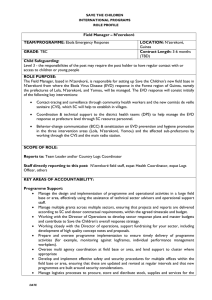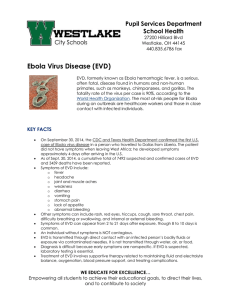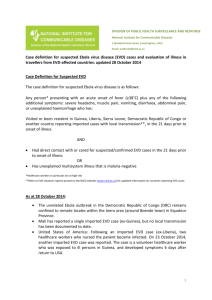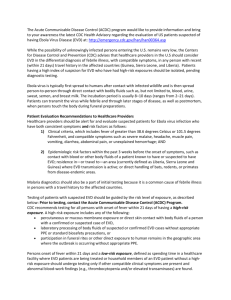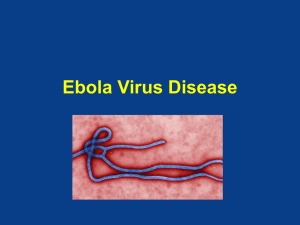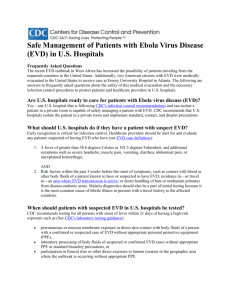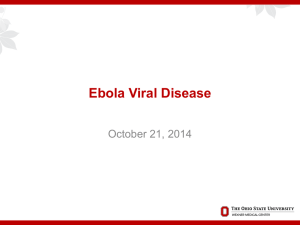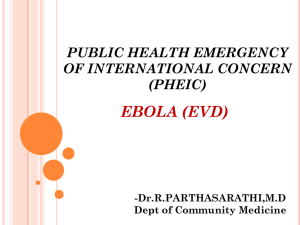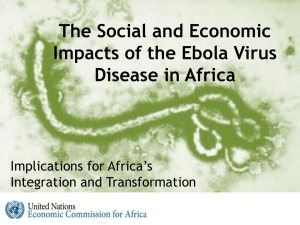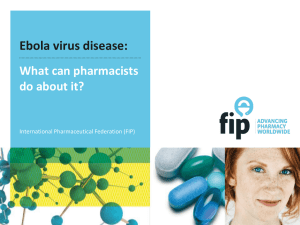Schools Breakout Session
advertisement
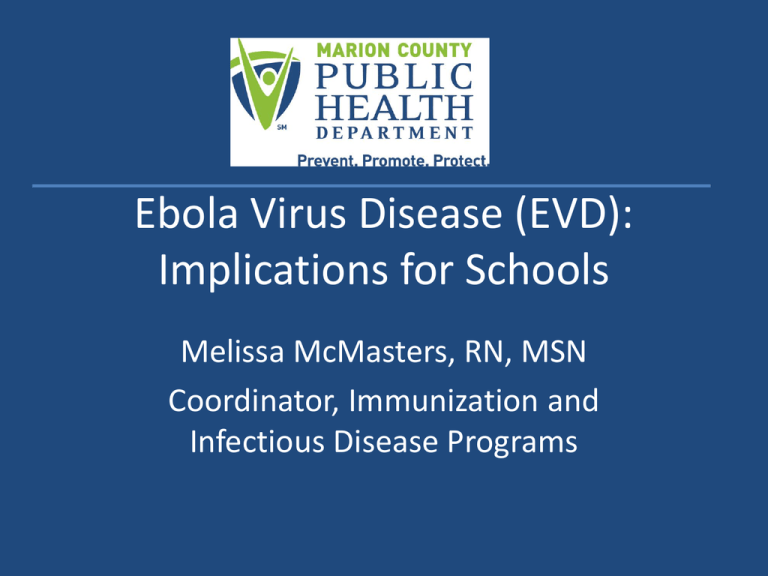
Ebola Virus Disease (EVD): Implications for Schools Melissa McMasters, RN, MSN Coordinator, Immunization and Infectious Disease Programs Objectives • Describe the clinical presentation of potential pediatric patients with EVD • Recommendations for schools • Recommendations for colleges and universities • How to talk to children about EVD Current West African Outbreak Source: Anthony England; @EbolaPhone Case Counts Country Total cases Lab-confirmed Deaths Guinea 1667 1409 1018 Liberia 6535 2515 2413 Sierra Leone 5338 3778 1510 13540 7702 4941 EVD in Children • Suspected index case in current outbreak: 2 year old who died in Guinea in December 2013 • Data in pediatric patients is lacking • In Guinea, 18% were children • Of 4 originally affected countries, 13.8% were younger than 15 EVD in Children • Children and adolescents represent a small number of documented cases • Cultural practice is to keep children away from sick family members Progression of EVD (Adults) Fever and Malaise Gastroenteritis Viral Sepsis Clinical Presentation of US Cases • 3 phases of Ebola Virus Disease (EVD) 1. Fever and Malaise (days 2-4) » Achy » Chills and Sweats » Flu like symptoms 2. Gastroenteritis (days 5-9) » » » » » » » Nausea Vomiting (projectile) Diarrhea (explosive) Significant fluid loss (4-12 L/day) Vascular leaking Oozing Nose and gum bleeds Clinical Presentation Cont’d 3. Viral Sepsis » » » » » » » Acute, critical phase Multi- organ failure ARDS Dialysis Mechanical ventilation Encephalopathy Death Course of Illness • Average of 28 days hospitalized • Range of illness from moderate to severe • All patients discharged reporting consistent and persistent generalized weakness and fatigue • Criteria: 2 negative PCR’s from blood and asymptomatic Presentation in Children • Non specific presentation similar to other pediatric infectious diseases • Fever, headache, myalgia followed by diarrhea and vomiting – 100% Febrile • Differential Diagnoses – Malaria – Measles – Typhoid Fever Treatment of EVD Pediatric Patients • Key is supportive care of complications – Hypovolemia – Electrolyte abnormalities – Nutritional supplementation – And then acute, critical care if progression to septic phase Pregnancy and Neonates • Pregnant women are not more susceptible • But do have increased risk for severe illness and death • Increased risk for spontaneous abortion and hemorrhaging • No known neonates have survived Monitoring Travelers • Currently MCPHD monitors all travelers from West Africa • Travelers from Sierra Leone, Guinea, and Liberia can only enter through 1 of 5 quarantine stations 1. John F. Kennedy New York 2. Dulles Washington D.C. 3. Liberty New York 4. O’Hare Chicago 5. Hartsfield-Jackson Atlanta Risk Levels for Travelers 1. Symptomatic individuals in the high, some, or low(but not zero) risk categories 2. Asymptomatic in high risk category 3. Asymptomatic in some risk category 4. Asymptomatic in the low (but not zero) risk category 5. No identifiable risk category Active vs. Direct Active Monitoring Active Monitoring Direct Active Monitoring • Local public health authority assumes responsibility • Daily communication • Assess for symptoms and fever • Minimum: Daily reporting of measured temperatures and symptoms to LHD and notify immediately if symptoms or fever develop • Local public health authority assumes responsibility • Direct observation • Assess for symptoms and fever • Minimum: Twice daily communication with one being observed and must notify LHD immediately if symptoms for fever develop Monitoring and Restrictions Risk Category Monitoring Travel Restrictions 1. Symptomatic Medical Evaluation Federal public health travel restrictions 2. Asymptomatic High Risk Direct Active Controlled movement Federal public health travel restrictions No commercial travel 3. Asymptomatic Some Risk Direct Active Local and State will consider 4. Asymptomatic Low Risk Active Allowed; must assure uninterrupted monitoring 5. No Risk N/A N/A For Schools • Asymptomatic low risk will be monitored by health department for 21 days and will be allowed to attend school • Asymptomatic some risk will be monitored by health department for 21 days and will not be allowed to attend school – How will their educational needs be addressed? – Plans for e-learning, etc. Caution • Issues of prejudice and discrimination • Last week 2 Senegalese boys (born in America) were allegedly attacked and beaten after one of them sneezed in the cafeteria – http://newyork.cbslocal.com/2014/10/27/nycleaders-say-african-children-bullied-at-school-inwake-of-ebola-scare/ Colleges and Universities • Level 3 Travel Warning for Liberia, Guinea, and Sierra Leone • Avoid non-essential travel • Postpone education-related travel • CDC reports a minimum of 6 months to get outbreak under control but could be much longer Why? • The health care systems in these countries are severely strained • Risk is not only EVD but routine emergency health care needs of visiting US citizens will likely not be met – Car accident yet nearest hospital is overwhelmed treating EVD patients Returning Students, Faculty and Staff • At this point, these individuals would fall under our active monitoring protocol • Student health centers should follow CDC recommendations that apply to all US healthcare settings • CDC does not recommend quarantining or isolating anyone based on travel history alone • Work with local health department References • CDC Ebola Website – Outbreak in West Africa http://www.cdc.gov/vhf/ebola/outbreaks/2014west-africa/index.html – Monitoring Travelers http://www.cdc.gov/vhf/ebola/exposure/monitori ng-and-movement-of-persons-with-exposure.html – Schools http://www.cdc.gov/vhf/ebola/children/index.ht ml
